The Oxygen Indicator Labels Market is estimated to be valued at USD 685.3 million in 2025 and is projected to reach USD 1,159.6 million by 2035, registering a compound annual growth rate (CAGR) of 5.4% over the forecast period.
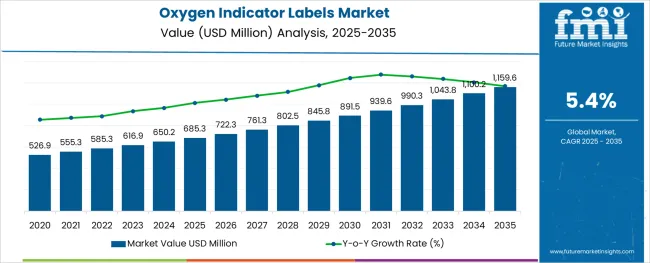
The oxygen indicator labels market is expanding steadily as food safety and quality control become increasingly important in the packaging industry. The demand for reliable indicators that monitor oxygen exposure has grown in response to consumer expectations for fresh and safe food products. Technological advances have improved the accuracy and durability of oxygen indicator labels, making them essential for perishable goods packaging.
Cheese producers have placed greater emphasis on maintaining product freshness, driving the adoption of oxygen indicators to detect package integrity and spoilage risks. Increasing regulations on food safety and the growth of ready-to-eat and packaged foods have further fueled market demand.
The market is expected to continue expanding as manufacturers and retailers seek innovative packaging solutions to extend shelf life and assure quality. Segment growth is anticipated to be led by non-reversible oxygen indicator labels and their application in the cheese industry due to high sensitivity requirements.
The market is segmented by Product Type and Application and region. By Product Type, the market is divided into Non-Reversible Oxygen Indicator Labels and Reversible Oxygen Indicator Labels. In terms of Application, the market is classified into Cheese, Sliced and cooked meat, Bread, Catering Pack, Airline meals, and Others. Regionally, the market is classified into North America, Latin America, Western Europe, Eastern Europe, Balkan & Baltic Countries, Russia & Belarus, Central Asia, East Asia, South Asia & Pacific, and the Middle East & Africa.
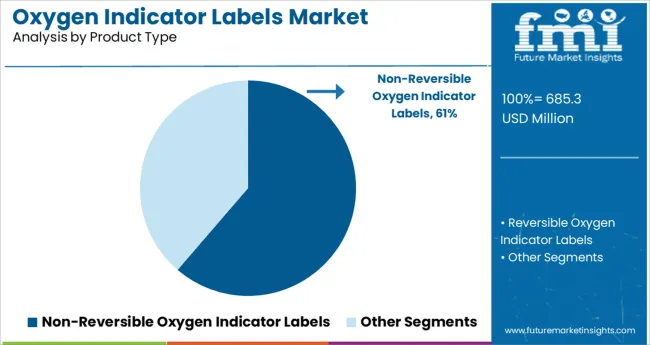
The non-reversible oxygen indicator labels segment is projected to hold 61.3% of the oxygen indicator labels market revenue in 2025, establishing itself as the leading product type. Growth in this segment has been driven by the labels’ ability to provide permanent visual indication of oxygen exposure, which is critical for ensuring product safety over the entire shelf life. These labels are favored for their reliability and ease of interpretation without requiring specialized equipment.
Their application is especially important in monitoring sealed packaging where oxygen presence can lead to spoilage. The demand for non-reversible labels has been supported by the need for tamper-evident packaging and compliance with food safety standards.
As packaging technology advances, the adoption of these labels is expected to increase across various perishable food categories.
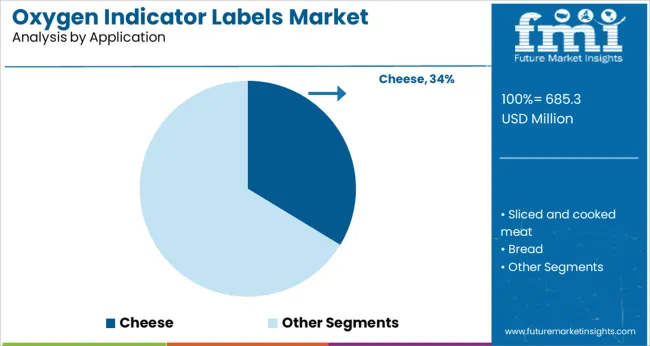
The cheese application segment is projected to contribute 33.7% of the oxygen indicator labels market revenue in 2025, making it the leading application area. Cheese products are particularly sensitive to oxygen exposure, which can affect flavor, texture, and shelf life. Producers have prioritized the use of oxygen indicator labels to monitor packaging integrity and detect potential contamination early.
The segment’s growth is also influenced by the rising consumption of packaged and specialty cheeses that require strict quality control.
Retailers and consumers alike benefit from improved confidence in product freshness, which has reinforced the use of oxygen indicators. As demand for packaged cheese products continues to rise globally, the cheese segment is expected to sustain its position as a primary application for oxygen indicator labels.
The oxygen indicator labels market has received a lot of traction in the industry. Oxygen indicator labels are experiencing high growth as consumers become increasingly interested in natural and organic products, propelling sales of oxygen indicator labels.
Oxygen indicator labels are crucial to ensuring the freshness and quality of food products. Various technologies transform the atmosphere in which food products are stored during packaging to maintain their quality and maximize their shelf life.
The oxygen indicator labels use a very diverse and easy-to-use technology that uses the change in color method to indicate that the modified atmosphere has been maintained within the packaging containers. The label uses a preserving technique in which different seasoning agents are adapted within packaging containers.
The oxygen indicator labels offer a perfect indication that the modified atmosphere has been maintained inside the packaging containers; such factors drive the growth of the oxygen indicator labels market share.
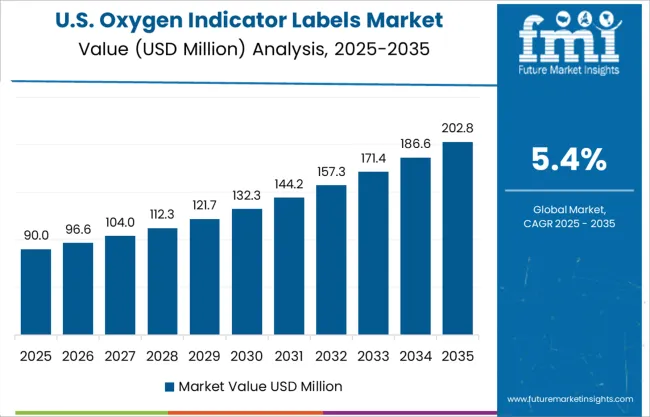
As of now, North America dominates the global oxygen indicator labels market with a 39% share value, thanks to consumer acceptance of intelligent packaging technologies.
In recent years, a wide range of intelligent packaging technologies has been developed that manufacturers and brand owners are already using. The oxygen indicator label belongs to the analytical packaging category as a member of intelligent packaging.
These oxygen indicator labels are used for safety and can be applied directly to the shelf life of food. Growing online food retail has led to an increase in demand for oxygen indicator labels.
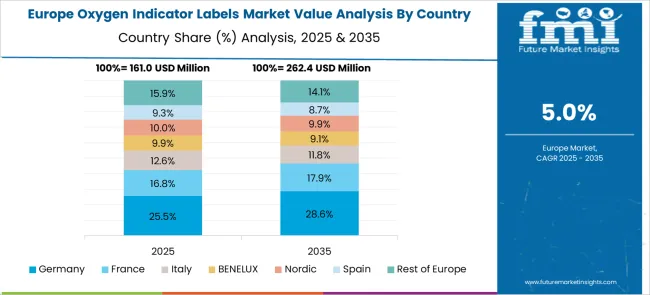
Besides North America, the Western Europe oxygen indicator labels market has a market share value of 29% and is expected to grow rapidly due to the growing demand for oxygen indicator labels. It is also expected that Africa will significantly contribute to the growth of the oxygen indicator labels market during the forecast period.
A large-scale oxygen indicator developed by Saarinen et al. (2020) relies on colorimetric changes, is activated by ultraviolet light, and can be printed or attached to the inside of packaging materials to provide an inexpensive leak indication; such developments are generating new opportunities in the oxygen indicator labels market.
According to Vu and Won (2013), ozone indicator labels can recover their original color if exposed to UV light. They have also developed a way to prevent the dye from seeping out when ozone indicator labels are exposed to UV light.
Some of the leading companies operating in the global membrane filter cartridge market include Emco Packaging and PreSens Precision Sensing GmbH.
According to the Packaging and Packaging Waste Directive (European Commission, 2020), European Union companies should ensure the environmental impact of the packaging operations they conduct. Waste Reduction Model (WARM; version 13) is US EPA's model for managing end-of-life food and waste [US EPA (USA Environmental Protection Agency), 2020].
In an attempt to find a cheaper MAP leak indicator, Saarinen et al. (2020) developed a large-scale oxygen indicator based on a colorimetric change and activated by ultraviolet light. The label can be attached to packaging material or printed on the packaging itself.
Emco Packaging developed a non-reversible oxygen indicator label for modified atmosphere packaging to indicate any leaks. OxySense uses luminescence to indicate leaks in modified atmosphere packaging; such developments are shifting the start-up ecosystem of the oxygen indicator labels market.
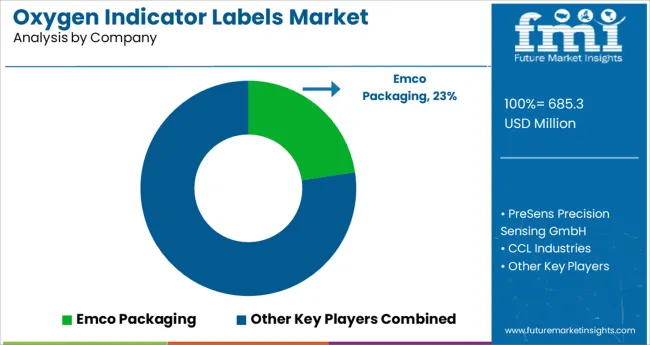
Some of the leading companies operating in the global oxygen indicator labels market include Emco Packaging and PreSens Precision Sensing GmbH.
To alert customers of leaks in modified atmosphere packaging, OxySense is a commercial luminescence indicator label, and Emco Packaging developed non-reversible O2 indicators.
In the USA, industries follow the US EPA's Waste Reduction Model (WARM; version 13) as their waste management model at the end of the life cycle of food and waste. The Packaging and Packaging Waste Directive (European Commission, 2020) requires companies in the European Union to minimize their environmental impact when packaging their products.
As part of their project, Vu and Won (2013) developed an O2 indicator that is activated by ultraviolet light and can recover its original color under oxygen conditions. They also found a way to prevent dye from seeping out of the O2 indicator labels by utilizing alginate.
| Report Attribute | Details |
|---|---|
| Growth Rate | CAGR of 5.4% from 2025 to 2035 |
| Base Year for Estimation | 2024 |
| Historical Data | 2020 to 2024 |
| Forecast Period | 2025 to 2035 |
| Quantitative Units | Revenue in million and CAGR from 2025 to 2035 |
| Report Coverage | Revenue Forecast, Volume Forecast, Company Ranking, Competitive Landscape, Growth Factors, Trends and Pricing Analysis |
| Segments Covered | End User, Shape, Target Population, Region |
| Regions Covered | North America; Latin America; Western Europe; Eastern Europe; Asia-Pacific; Japan; Middle East and Africa |
| Key Countries Profiled | USA, Canada, Brazil, Mexico, Germany, UK, France, Spain, Italy, Russia, Poland, Australia, New Zealand, China, India, Japan, GCC, South Africa, North Africa |
| Key Companies Profiled | Advanced Emco Packaging; PreSens Precision Sensing GmbH |
| Customization | Available Upon Request |
The global oxygen indicator labels market is estimated to be valued at USD 685.3 million in 2025.
It is projected to reach USD 1,159.6 million by 2035.
The market is expected to grow at a 5.4% CAGR between 2025 and 2035.
The key product types are non-reversible oxygen indicator labels and reversible oxygen indicator labels.
cheese segment is expected to dominate with a 33.7% industry share in 2025.






Our Research Products

The "Full Research Suite" delivers actionable market intel, deep dives on markets or technologies, so clients act faster, cut risk, and unlock growth.

The Leaderboard benchmarks and ranks top vendors, classifying them as Established Leaders, Leading Challengers, or Disruptors & Challengers.

Locates where complements amplify value and substitutes erode it, forecasting net impact by horizon

We deliver granular, decision-grade intel: market sizing, 5-year forecasts, pricing, adoption, usage, revenue, and operational KPIs—plus competitor tracking, regulation, and value chains—across 60 countries broadly.

Spot the shifts before they hit your P&L. We track inflection points, adoption curves, pricing moves, and ecosystem plays to show where demand is heading, why it is changing, and what to do next across high-growth markets and disruptive tech

Real-time reads of user behavior. We track shifting priorities, perceptions of today’s and next-gen services, and provider experience, then pace how fast tech moves from trial to adoption, blending buyer, consumer, and channel inputs with social signals (#WhySwitch, #UX).

Partner with our analyst team to build a custom report designed around your business priorities. From analysing market trends to assessing competitors or crafting bespoke datasets, we tailor insights to your needs.
Supplier Intelligence
Discovery & Profiling
Capacity & Footprint
Performance & Risk
Compliance & Governance
Commercial Readiness
Who Supplies Whom
Scorecards & Shortlists
Playbooks & Docs
Category Intelligence
Definition & Scope
Demand & Use Cases
Cost Drivers
Market Structure
Supply Chain Map
Trade & Policy
Operating Norms
Deliverables
Buyer Intelligence
Account Basics
Spend & Scope
Procurement Model
Vendor Requirements
Terms & Policies
Entry Strategy
Pain Points & Triggers
Outputs
Pricing Analysis
Benchmarks
Trends
Should-Cost
Indexation
Landed Cost
Commercial Terms
Deliverables
Brand Analysis
Positioning & Value Prop
Share & Presence
Customer Evidence
Go-to-Market
Digital & Reputation
Compliance & Trust
KPIs & Gaps
Outputs
Full Research Suite comprises of:
Market outlook & trends analysis
Interviews & case studies
Strategic recommendations
Vendor profiles & capabilities analysis
5-year forecasts
8 regions and 60+ country-level data splits
Market segment data splits
12 months of continuous data updates
DELIVERED AS:
PDF EXCEL ONLINE
Market Leaders & Share in Oxygen Indicator Labels Manufacturing
Oxygen-Scavenger Sachet Feeders Market Forecast and Outlook 2025 to 2035
Oxygen-free Copper Market Size and Share Forecast Outlook 2025 to 2035
Oxygen Barrier Films And Coatings For Dry Food Market Size and Share Forecast Outlook 2025 to 2035
Oxygen Scavenger Masterbatch Market Size and Share Forecast Outlook 2025 to 2035
Oxygen Conservation Devices Market Analysis – Size, Share & Forecast 2025 to 2035
Oxygen Therapy Equipment Market Insights – Trends & Forecast 2024 to 2034
Oxygen Barrier Films Market
Oxygen Delivery Units Market
Oxygen Scavenger Market
Oxygen Market
Trace Oxygen Analyzer Market Analysis - Size, Share & Forecast 2025-2035
Nasal Oxygen Cannula Market
Liquid Oxygen Generator Market Size and Share Forecast Outlook 2025 to 2035
Muscle Oxygen Monitors Market Size and Share Forecast Outlook 2025 to 2035
Active Oxygens Market Analysis by Product Type, Application and Region: Forecast for 2025 to 2035
Global Portable Oxygen Concentrator Market Analysis – Size, Share & Forecast 2024-2034
Aircraft Oxygen System Market
Dissolved Oxygen Meters and Controllers Market Size and Share Forecast Outlook 2025 to 2035
High-Flow Oxygen Therapy Devices Market Analysis – Size, Share & Growth 2025–2035

Thank you!
You will receive an email from our Business Development Manager. Please be sure to check your SPAM/JUNK folder too.
Chat With
MaRIA